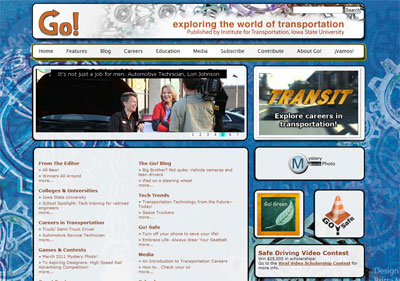InTrans / Mar 16, 2011
Go!-ing after New Transportation Professionals
 The recent arrival of Dr. Rema Nilakanta, Go!’s first full-time coordinator, has injected critical expertise into the experimental e-zine. With an educational and professional background in using technology to enhance student learning, she is implementing a plan to heighten Go!’s impact.
The recent arrival of Dr. Rema Nilakanta, Go!’s first full-time coordinator, has injected critical expertise into the experimental e-zine. With an educational and professional background in using technology to enhance student learning, she is implementing a plan to heighten Go!’s impact.
What is Go! ?
Go! (www.go-explore-trans.org) is a free, online magazine designed to attract teenagers to educational and career opportunities in transportation. Along with ¡Vamos!, its sister Spanish-version website, Go! is produced by the Institute for Transportation (InTrans) .
Developed for and with young people, Go! engages them by providing fun, sometimes quirky content and a dynamic visual interface to capture teenagers’ imaginations and actively involve them in the site. In its first few years Go! has accomplished several goals:
- Established a loyal readership with over 800 subscribers and about 8,000 visitors monthly from more than 100 countries.
- Published 18 issues (and 5 of ¡Vamos!) and set up social network sites on Facebook and Twitter.
- Developed a series titled Curriculum Connections, which consists of short articles that teachers can use to link Go! content with STEM (science, technology, engineering, and mathematics) concepts.
Go!ing into the future
One of Nilakanta’s priorities has been to energize visitors’ online experience with Go!. She and graduate students Britta Mennecke (graphic design) and Bennett Stone (human-computer interaction) have transformed the e-zine from a basic website to an engaging experience.
The revamped website, which launched in December 2010, communicates through hands-on games, puzzles, contests, and audio/video clips that supplement text.
Target audience as “co-publishers”
Another priority is to directly involve middle- and high school students from around the country in envisioning, designing, and producing Go!’s content and functionality.
“Ultimately,” says Nilakanta, “Go!’s effectiveness depends on its ability to transform young people from passive visitors to the website to active stakeholders.”
She envisions tomorrow’s Go! as a dynamic, interactive, collaborative, and organic resource/project for teachers and students and parents.
The Go! team is developing partnerships with middle and senior high schools that want to incorporate Go! into their classroom activities. Go! will provide a venue for publishing students’ original transportation-related content—text, games, video clips, photos, etc.—in effect, making students co-publishers of the site.
“We are inviting teenagers to help develop e-content and functionality that will attract other young people to Go!,” Nilakanta says. “This appeals to teens’ technical savvy. It’s a win-win approach.”
Participating students will improve their research, leadership, writing, and design skills. They will likely come face-to-face with how the science and math concepts they are learning in school are applicable to real-world challenges. In the process, they will learn about a topic that may not be typically on their radar screens: educational and career opportunities in transportation.
Collaborating on workforce development
“Go! has the potential to be a cornerstone tool in the national transportation workforce development effort,” says Wes Lum, Chief, Office of Safety Innovation and Cooperative Research, Division of Research and Innovation, California Department of Transportation.
Go! is a major funded professional-development tool of the Midwest Transportation Consortium, a Tier 1 U.S. DOT University Transportation Center (UTC) at Iowa State University, directed by Shauna Hallmark. In addition, Go! receives support from the Federal Highway Administration through the Eisenhower Fellowship program.
The FHWA and MTC funds have primarily supported graduate student assistants as writers, designers, and website developers. Go! is leveraging this support through cooperative partnerships with Iowa State’s College of Education, Spanish program, journalism school, and other university departments.
To enhance Go!’s impacts, and to ensure its long-term viability, strong collaborations with other organizations are invaluable.
“Our online magazine is just one of many transportation recruitment programs,” says Shashi Nambisan, director of InTrans. “Each program offers something unique. If we coordinate and work together, we can all benefit.”
The Go! program is establishing connections with several UTCs and Local Technical Assistance Programs across the country, Young Professionals in Transportation, regionally diverse state departments of transportation, and a growing list of other organizations.
For more information
Visit Go! online, www.go-explore-trans.org, or contact Dr. Nilakanta, 515-294-1945, rema@iastate.edu.